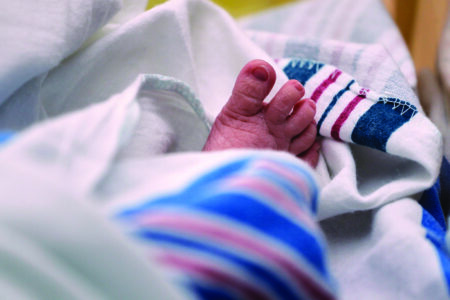Clubfoot deformity remains a mystery
ESCANABA — The birth of a child, although highly anticipated, can be a stressful undertaking. This can be a challenging time emotionally and physically for the mother. But all concerned tend to have high stress levels around this event. Will the mother avoid some of the complications of childbirth? Will the co-parent stay upright throughout the process? Most importantly, will the infant be okay, possessed of ten fingers and ten toes. Another relevant and appropriate question: will everything be put on straight?
When a foot isn’t, chances are good it is due to the presence of a clubfoot. This is a common congenital deformity, occurring in roughly two out of every thousand births. This makes it one of the most common birth defects we know of and, like so many similar conditions, it varies greatly in severity. About half of the children born with a clubfoot will have it in both feet, with males more commonly affected than females.
Technically termed Talipes Equinovarus, a clubfoot entails an abnormally positioned foot, such that the foot is twisted in three different directions. First, the middle part of the foot is angled downward. The next component is where the metatarsal bones are bent over towards the middle of the body. Additionally, the rearfoot is tilted inward. Lastly, the heel bone is pulled upward, often causing the ankle to be fully flexed downward. This latter finding seems to be the result of an excessively tight heel cord (the Achilles tendon-muscle complex) pulling the heel bone up, and therefore the foot down. As should be predictable, an appendage so afflicted will not be functional.
One might think that a condition so common would be well studied and precisely defined. Unfortunately, this is not the case: we have only theories and guesswork as to why children are born with this. Many theories have been proposed to explain the etiology of idiopathic clubfoot. One mentioned in the literature is a shortened Achilles tendon, which may prevent the normal process of “unfolding” of the foot during development in the womb. Environmental factors are also at play, with cigarette smoking by the mother during gestation an independent risk factor for clubfoot.
Generally, TEV, talipes equinovarus, is present alone and there is no other associated disease, yet it can be part of some underlying condition. Most cases are classified as idiopathic (meaning we don’t know the cause), although there are clearly a number of factors involved. There is a hereditary component and so may be passed down through families. This is evidenced by the differences in clubfoot prevalence across various ethnic populations. Again, for most infants, TEV is usually an isolated problem occurring in an otherwise healthy newborn.
Treatment is recommended since the deformity makes it nearly impossible to have a normal gait pattern. Early intervention is vital since the abnormally positioned extremity becomes more fixed with time. But surgical correction of the deformity in newborns is rarely attempted initially as a form of treatment due to the scarring and high rate of complications.
Manipulation of the foot out of the deformed position has become the gold standard globally following the widespread dissemination of the Ponsetti method. With this technique, continuous force is applied to the affected joints over time, stretching the tightened ligaments and joint capsules to relax gradually until they achieve the proper anatomical position. Once sufficient mobility of the pathologic tissue is achieved, an above-knee, long leg plaster cast is applied to hold the limb in the new attitude. The cast is changed weekly with most responding sufficiently after 5-7 weeks.
This technique, developed by Dr. Ignacio Ponsetti, has survived the test of time. But it requires a series of manipulations and subsequent castings, followed by daily application of a specialized brace once the degree of correction has been achieved. When either of these critical steps is not properly performed, or not maintained for the correct length of time, recurrence of the abnormality is typically the result. When there is a relapse of the clubfoot, surgery is usually recommended but perfect correction is unlikely for these individuals and prescription foot orthotics, when correctly fit and prescribed, can provide tremendous relief of gait-related pain.
When treatment begins in a timely fashion, within the first three weeks of life, most individuals grow up without physical impairment or pain, and a healthy gait pattern is observed. This treatment has a success rate of over 90 percent, with obvious improvement noted after just a week or two of casting.
It is common for the milder forms of clubfoot to go unrecognized and consequently untreated. Even more common is the individual with treated clubfoot who experiences some relapse of the deformity but learns to live with it. This foot type often leads eventually to some level of disability since it does not function well biomechanically. This may be from the original deformity or because of complications resulting from the treatment.
A definitive understanding of the causes for a clubfoot deformity continues to elude us. Theories abound but none are held in high esteem. Still, the widespread acceptance and practice of the Ponsetti method over the last 2 decades has provided great benefits to those children afflicted with this deformity. Still, even with use of this method, a failure to follow the regimen exactly too often allows recurrence of the disfigured part. Even worse, if untreated, it will persist into adulthood, severely altering gait and adversely affecting the lives of those born with this common but potentially disabling condition.
— — —
Dr. Conway McLean is a physician practicing foot and ankle medicine in the Upper Peninsula, with offices in Escanaba, Marquette, and L’Anse. McLean has lectured internationally on wound care and surgery, being board certified in surgery, orthotic therapy and wound care. His articles on health and wellness appear in multiple local and national publications. Dr. McLean welcomes subject requests for future articles at drcmclean@outlook.com.

